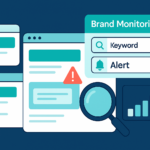17 Dec

How Do You Conduct a Reputation Audit? A Step-by-Step Guide
In the interconnected and globalized economy, the potential for spreading a personal or business brand is limitless. Unfortunately, this unprecedented reach for growing brands also comes with equally large opportunities for damage from competitors, unhappy customers or former staff, reviews, social media content, and more. This makes reputation monitoring an essential part of operations for anyone with a sizable or growing presence for their personal or business brand.
But how can you monitor your reputation in a 24/7, constantly shifting digital environment? Enforcing a reputation auditing regime is one practical method for staying on top of potential issues and dealing with them proactively to protect a brand. As a monitoring software platform, we’ve put together a best practices guide for you to follow to do this yourself. Let us walk you through it.
What is a reputation audit?
A reputation audit is the process of systematically analyzing and evaluating your digital footprint to understand how others perceive you, your business, or your brand online.
Key Goals of a Reputation Audit:
Identify both positive and negative content about your brand.
Assess online reviews, news articles, blog posts, and social media mentions.
Highlight opportunities to enhance your image and address areas of concern.
Whether you’re a small business trying to build trust, a CEO protecting your professional image, or a brand managing online reviews, conducting a reputation audit ensures you stay informed and in control of your online presence.
Who Should Conduct a Reputation Audit?
A reputation audit is valuable for anyone who depends on public perception to succeed. Here’s a breakdown of who benefits most:
1. Brands and Businesses
Small businesses, startups, and established companies need to maintain trust and credibility with customers.
Industries like hospitality, healthcare, and e-commerce are particularly reliant on customer reviews.
2. Public Figures and Leaders
Executives, politicians, and professionals in leadership roles need to monitor media coverage and public opinion.
Their reputation directly influences partnerships, opportunities, and trust.
3. Job Seekers and Professionals
Employers often review candidates’ digital footprints during the hiring process.
A clean, professional online reputation improves career opportunities.
4. Influencers and Content Creators
For individuals whose livelihoods rely on social media, maintaining a positive reputation helps retain audience trust.
If you interact with customers, followers, or the media, conducting a reputation audit ensures you’re aware of how you’re perceived—and can take control of your narrative.
Reputation Monitoring Software and Tools to Know
Fortunately, several tools simplify the process of monitoring and auditing your reputation. Here are some of the most effective options:
1. Monitoring Software
- Tools like ChangeTower allow you to create automated monitors on key sites (like review platforms or competitor websites) to receive instant alerts of your brand mentions and react in real-time.
2. Google Alerts
A free tool that sends email notifications when specific keywords (e.g., your name or brand) appear online.
3. Review Platforms
Platforms like Google Business Profile, Yelp, and Trustpilot allow you to monitor customer reviews and ratings.
4. Social Listening Tools
Tools like Mention, Hootsuite, and Sprout Social help track brand mentions, hashtags, and sentiment across social media.
5. SEO and Content Tools
Platforms like SEMrush and Ahrefs can help identify negative search results ranking for your name or business and offer insights for improvement.
How to Conduct a Reputation Audit: Step by Step
Step 1: Search for Your Brand or Name Online
Use Google, Bing, and other search engines to search for your brand, personal name, and related keywords.
Review the first few pages of results for websites, blogs, and articles.
Pay attention to Google Images for any damaging or outdated photos.
Step 2: Evaluate Customer Reviews
Audit customer reviews on platforms like Google, Yelp, Amazon, and Trustpilot.
Analyze feedback to identify recurring themes—both positive and negative.
Step 3: Monitor Social Media Mentions
Use social listening tools to track mentions, comments, or hashtags about your brand.
Check platforms like Twitter, Facebook, LinkedIn, and Instagram.
Step 4: Use Tools Like ChangeTower to Track Content Changes
Monitor websites and review pages where your reputation is at risk.
Set up ChangeTower alerts for specific keywords or URLs to detect new mentions or changes.
Step 5: Compile Findings and Assess Overall Sentiment
Categorize your findings into:
Positive: Testimonials, success stories, and favorable mentions.
Neutral: Informative but unbiased mentions.
Negative: Damaging reviews, outdated articles, or false claims.
Create a report summarizing areas of concern and opportunities for improvement.
Action Steps if Damaging Content is Found
1. Respond to Negative Reviews Professionally
Address reviews promptly, professionally, and empathetically.
Offer solutions or clarify misunderstandings to demonstrate responsiveness.
2. Request Content Removal (When Appropriate)
Contact website owners to request removal of inaccurate, defamatory, or outdated content.
For serious issues, consult legal professionals for takedown requests.
3. Push Negative Content Down with Positive Content
Create high-quality blog posts, press releases, and social media content that highlight successes.
Use SEO strategies to rank positive content higher in search results.
4. Monitor for Updates
Use ChangeTower and Google Alerts to track new content or changes over time.
Stay proactive to address issues before they spread.
5. Engage with Your Audience
Build a positive reputation by engaging with customers and followers through:
Social media responses
Community forums
Transparency in addressing concerns
Adam Hausman has worked with ChangeTower since its founding in 2018 and is passionate about the potential of website monitoring software in industries including SEO, compliance monitoring, competitive intelligence, and more. Also founder of Greenlight Growth Marketing, he holds degrees from Indiana University (BA English/Psychology 2008) and the University of Illinois-Chicago (M.Ed. Secondary Education 2012). He lives in Maine with his wife, 2 kids, and 2 annoying cats.





Adam Hausman